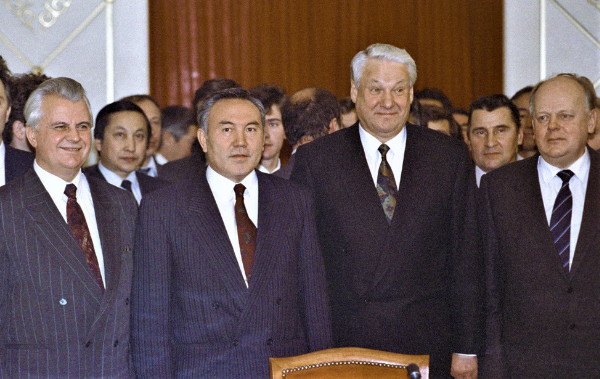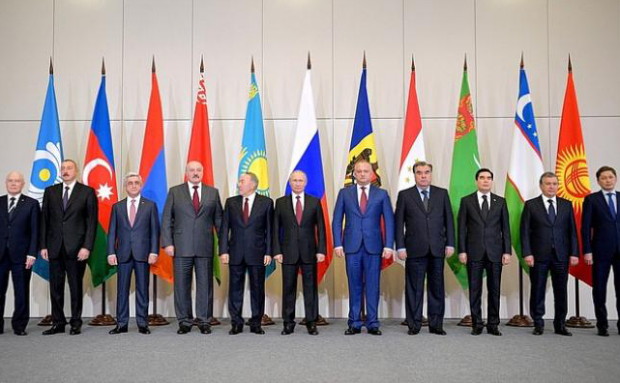Commonwealth of Independent States
Commonwealth of Independent States (Ukrainian: Співдружність незалежних держав; Spivdruzhnist nezalezhnykh derzhav or СНД; CIS). An association of 12 former republics of the Union of Soviet Socialist Republics (excluding the Baltic states) for co-operation on and co-ordination of their domestic and foreign policies. Not a truly supranational entity like the European Union (EU), it is nonetheless patterned on the latter and is aiming to become its Eurasian counterpart. With its Executive Committee, the permanent headquarters in Minsk, Belarus, the CIS is comprised of a series of councils (heads of state and government, ministers of foreign affairs and defense, and border guards commanders), an Inter-parliamentary Assembly, and an economic court. In January 2000, Russian President Vladimir Putin was elected chairman of the Council of Heads of State, and Ukrainian Prime Minister Viktor Yushchenko was elected head of the Council of Heads of Government. As of January 2020, both positions were held by the President of Turkmenistan, Gurbanguly Berdymukhamedov. An Economic Council, the executive arm of the councils of heads of state and of government, was also established to create a free trade zone and to deepen multilateral economic cooperation among the member-states. In spite of its ambition to become like the EU, it has been a relatively powerless organization able only to reconcile differences rather than to act as a supranational government; only one quarter of its multilateral agreements have actually been implemented. Its Charter was adopted by the Council of Heads of State on 22 January 1993, although not all CIS member countries have ratified it (Ukraine has not). Although one of its founders, Ukraine has never been a full-fledged member of the CIS—more of a participant-observer.
The CIS came into being on 8 December 1991, when the leaders of Belarus, Russia, and Ukraine signed the Belavezha Agreement establishing it at a meeting in Belavezha Pushcha near Minsk. That agreement not only explicitly transformed the republics into sovereign states but also annulled the 1922 treaty which had created the USSR, and which was thereby declared defunct. On 21 December 1991, eight more republics joined by signing a protocol to the earlier agreement and by adopting the Alma-Ata Declaration confirming their intent to cooperate. From that date the USSR actually ceased to exist. Georgia was the last to join, doing so in December 1993, but then withdrawing in 2009 following the previous year’s brief war with Russia.
From the very beginning a fundamental disagreement regarding the nature and purpose of the CIS has characterized the orientation of its two principal members, Ukraine and Russia, towards the organization. Russian policy regarded it as an instrument of collective security and integration, with Russia itself as the primary peacemaker, the CIS territory as a Russian sphere of influence, and the Commonwealth organization as almost a reincarnation of the USSR under Russian leadership. Ukrainian policy viewed it as a convenient forum for necessary non-security (primarily economic) cooperation and as a transitional body. Consequently, Ukraine has frustrated the project of creating a combined CIS armed forces under Russian command in favor of its own national army, and has taken a wary stance towards various other activities of the organization. When nine heads of state signed the Agreement on the Creation of an Economic Union in December 1993, Ukraine waited until April 1994 to join, and then only as an associate member. And it was not until 1999 that Ukraine became a member of the Inter-parliamentary Assembly which had been established in 1992. Invited by Russia in 2011 to join the newly-invented Customs Union, Ukraine declined this as incompatible with its World Trade Organization (WTO) status.
Policy under President Leonid Kuchma was much more pragmatic than that of his predecessor, Leonid Kravchuk, striving for greater cooperation with Russia within the CIS while preserving Ukraine's sovereignty. Ukraine has tried to minimize its involvement in the multilateral aspects of the CIS and has favored the development of bilateral relations with the other member-states. It sees a need to cooperate with the CIS, but simultaneously to work for its own integration into European organizations. Ukraine was the first CIS country to join NATO’s Partnership for Peace Program. Under Russian President Vladimir Putin, Russia’s own concerns about security and defense were placed at the fore in CIS policy, while Ukraine’s preference for a free-trade zone was agreed to only in 2011 with just eight states signing on.
As a counterweight to Russia's predominance in the CIS, Ukraine has cultivated the GUUAM (Georgia–Ukraine–Uzbekistan–Azerbaijan–Moldova) alliance, but has made no truly significant headway with it. In 2001, Uzbekistan suspended its membership; the remaining entity in 2006 changed its name to the Organization for Democracy and Economic Development—GUAM. As of December 2019, it was still working on strengthening economic cooperation, establishing a free trade zone, and building a transportation corridor linking member-states.
In 2014, it was Ukraine’s turn to head the CIS, but in view of the Russian invasion this obligation was suspended and the long process of withdrawal from the organization began. Early in 2018, President Petro Poroshenko issued a decree recalling all the country’s representatives from CIS bodies and the office of Ukraine in Minsk was closed. Renunciation of agreements followed. By February 2019, the withdrawal (or, more precisely, suspension) process was declared accomplished.
The failure of the CIS to evolve into a genuinely international organization has been attributed to the vagueness of its original goals, as well as its inherent inability under Russian leadership to promote economic cooperation, market liberalization, or democratization. On the latter score, for instance, the CIS institute for election monitoring has as its purpose the counteracting of foreign election observers’ activities and reports. It has not managed very well even the ‘civilized divorce’ required by the collapse of the USSR, but has devolved into a talking shop. The only two of its states at this point actively pursuing integration are Russia and Belarus, perhaps motivated by considerations of the further extension of President Vladimir Putin’s term of office.
BIBLIOGRAPHY
Brzezinski, Z.; Sullivan, P. (eds). Russia and the Commonwealth of Independent States: Documents, Data, and Analysis (Armonk, NY–London 1997)
Solchanyk, R. ‘Ukraine, Russia, and the CIS,’ in Ukraine in the World: Studies in the International Relations and Security Structure of a Newly-Independent State, ed L. A. Hajda (Cambridge, Mass. 1998)
Olcott, M.B.; Åslund, A.; Garnett, S.W. Getting It Wrong: Regional Cooperation and the Commonwealth of Independent States (Washington, DC 1999)
Libman, A. ‘Commonwealth of Independent States and the Eurasian Economic Community,’ in Finzio, G.; Levi, L.; and Vallinoto, N. (eds). The Democratization of International Organizations (Moncalieri 2011)
Engle, E. ‘The EU, Russia, and the Commonwealth of Independent States,’ in Engle, E. (ed). Russia, the European Union and the CIS (The Hague 2012)
Budkin, V. ‘Two Decades of the Commonwealth of Independent States: Potentialities and Unjustified Hopes,’ Problems of Economic Transition, 56, no. 2 (June 2013)
Commonwealth of Independent States web site http://www.cis.minsk.by/
Bohdan Harasymiw
[This article was written in 2020.]


